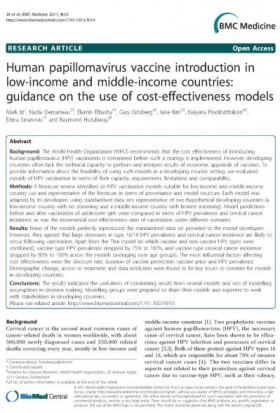This website uses cookies so that we can provide you with the best user experience possible. Cookie information is stored in your browser and performs functions such as recognising you when you return to our website and helping our team to understand which sections of the website you find most interesting and useful.
Human Papillomavirus Vaccine introduction in low and middle Income countries guidance on the use of Cost-effectiveness models.(2011)

รายละเอียดเพิ่มเติม
Human papillomavirus vaccine introduction in low and middle income countries:
guidance on the use of cost-effectiveness models
Mark Jit1, Nadia Demarteau2†, Elamin Elbasha3†, Gary Ginsberg4†, Jane Kim5†, Naiyana Praditsitthikorn6†, Edina Sinanovic7† and Raymond Hutubessy8*
† Contributed equally
8 Initiative for Vaccine Research, World Health Organization, 20 Avenue Appia, 1211 Geneva, Switzerland
Background
The World Health Organization recommends that the cost-effectiveness of introducing human papillomavirus (HPV) vaccination is considered before such a strategy is implemented. However, developing countries often lack the technical capacity to perform and interpret results of economic appraisals of vaccines. To provide information about the feasibility of using such models in a developing country setting, we evaluated models of HPV vaccination in terms of their capacity, requirements, limitations and comparability.
Methods
A literature review identified six HPV vaccination models suitable for low and middle income country use and representative of the literature in terms of provenance and model structure. Each model was adapted by its developers using standardised data sets representative of two hypothetical developing countries (a low income country with no screening and a middle income country with limited screening). Model predictions before and after vaccination of adolescent girls were compared in terms of HPV prevalence and cervical cancer incidence, as was the incremental cost-effectiveness ratio of vaccination under different scenarios.
Results
None of the models perfectly reproduced the standardised data set provided to the model developers. However, they agreed that large decreases in type 16/18 HPV prevalence and cervical cancer incidence are likely to occur following vaccination. Apart from the Thai model (in which vaccine and non-vaccine HPV types were combined), vaccine-type HPV prevalence dropped by 75-100%, and vaccine-type cervical cancer incidence dropped by 80-100% across the models (averaging over age groups). The most influential factors affecting cost-effectiveness were the discount rate, duration of vaccine protection, vaccine price and HPV prevalence. Demographic change, access to treatment and data resolution were found to be key issues to consider for models in developing countries.
Conclusions
The results indicated the usefulness of considering results from several models and sets of modelling assumptions in decision making. Modelling groups were prepared to share their models and expertise to work with stakeholders in developing countries.




